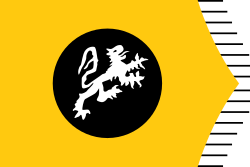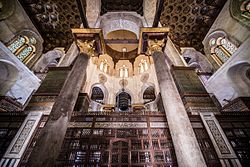Mamluk Sultanate
The Mamluk Sultanate (Arabic: سلطنة المماليك), also known as Mamluk Egypt or the Mamluk Empire, was a state that controlled Egypt, The Levant, and Hejaz from 1250 to 1517.[5][6][7] The first sultans (kings) of the Mamluk Sultanate were mamluks (slave-soldiers) in the armies of the Ayyubid dynasty. The Mamluk Sultanate was the strongest military power in the central Muslim world. They fended off the Mongols and exterminated the Crusaders in the Holy Land (The Levant).[8] The Mamluk sultans also controlled south-eastern Asia Minor and western Arabia.[8] Most of the sultanate's mamluks were Turkic people or Circassians.[7][5] The Arabic language was the state's and the government's most important language. Most of the sultans carried Arabic names and were heavily Arabized.[7]
Mamluk Sultanate | |||||||||||||||||||||||
|---|---|---|---|---|---|---|---|---|---|---|---|---|---|---|---|---|---|---|---|---|---|---|---|
| 1250–1517 | |||||||||||||||||||||||
| ' | |||||||||||||||||||||||
 Extent of the Mamluk Sultanate under Sultan an-Nasir Muhammad | |||||||||||||||||||||||
| Capital | Cairo | ||||||||||||||||||||||
| Common languages | |||||||||||||||||||||||
| Religion |
| ||||||||||||||||||||||
| Government | Sultanate under ceremonial Caliphate[4] | ||||||||||||||||||||||
| Caliph | |||||||||||||||||||||||
• 1261 | Al-Mustansir (first) | ||||||||||||||||||||||
• 1262–1302 | Al-Hakim I | ||||||||||||||||||||||
• 1406–1414 | Abū al-Faḍl Al-Musta'in | ||||||||||||||||||||||
• 1508–1516 | Al-Mutawakkil III (last) | ||||||||||||||||||||||
| Sultan | |||||||||||||||||||||||
• 1250 | Shajar ad-Durr (first) | ||||||||||||||||||||||
• 1250–1257 | Izz al-Din Aybak | ||||||||||||||||||||||
• 1260–1277 | Baibars | ||||||||||||||||||||||
• 1516–1517 | Tuman bay II (last) | ||||||||||||||||||||||
| History | |||||||||||||||||||||||
• | 2 May 1250 | ||||||||||||||||||||||
• | 22 January 1517 | ||||||||||||||||||||||
| |||||||||||||||||||||||
Mamluk Sultanate Media
Enthroned ruler and attendants in the Baptistère de Saint Louis (1320–1340). This is a probable depiction of Sultan Baybars.
Enameled and gilded bottle with the scene of battle. Egypt, late 13th century. Metropolitan Museum of Art
The siege of Tripoli, led against the Crusaders by the Mamluks of Qalawun in 1289
Interior of the Mausoleum of Sultan Qalawun in Cairo (1284–1285)[9]
Interior of the Al-Nasir Muhammad Mosque in the Citadel of Cairo (1318–1335)[10]
References
- ↑ Rabbat 2001, p. 69.
- ↑ Fischel 1967, p. 72.
- ↑ Turan, Fikret; Boeschoten, Hendrik; Stein, Heidi (2007). "The Mamluks and Their Acceptance of Oghuz Turkish as Literary Language: Political Maneuver or Cultural Aspiration?". Turcologica. Harrassowitz.
- ↑ Stilt, Kristen (2011). Islamic Law in Action: Authority, Discretion, and Everyday Experiences in Mamluk Egypt. OUP Oxford. ISBN 978-0-19-960243-8.
- ↑ 5.0 5.1 Keough, Leyla (2010). "Mamluk State". In Gates, Henry Louis, Jr.; Appiah, Kwame Anthony (eds.). Encyclopedia of Africa (online ed.). Oxford University Press. doi:10.1093/acref/9780195337709.001.0001. ISBN 978-0-19-533770-9.
- ↑ Kazhdan, Alexander P.; Talbot, Alice-Mary (2005) [1991]. "Mamlūks". In Kazhdan, Alexander P. (ed.). The Oxford Dictionary of Byzantium (online ed.). Oxford University Press. doi:10.1093/acref/9780195046526.001.0001. ISBN 978-0-19-504652-6.
- ↑ 7.0 7.1 7.2 Bloom, Jonathan M.; Blair, Sheila S., eds. (2009). "Mamluk". The Grove Encyclopedia of Islamic Art and Architecture (online ed.). Oxford University Press. doi:10.1093/acref/9780195309911.001.0001. ISBN 978-0-19-530991-1.
- ↑ 8.0 8.1 Esposito, John L., ed. (2003). "Mamluks". The Oxford Dictionary of Islam (online ed.). Oxford University Press. doi:10.1093/acref/9780195125580.001.0001. ISBN 978-0-19-512558-0.
- ↑ Behrens-Abouseif 2007, pp. 132–134.
- ↑ Behrens-Abouseif 2007, pp. 173–175.







